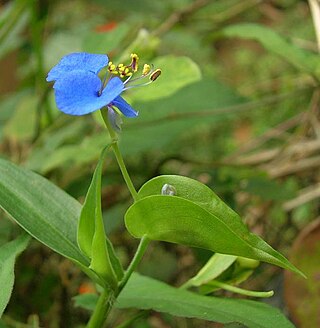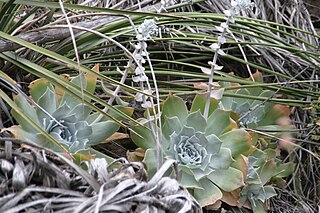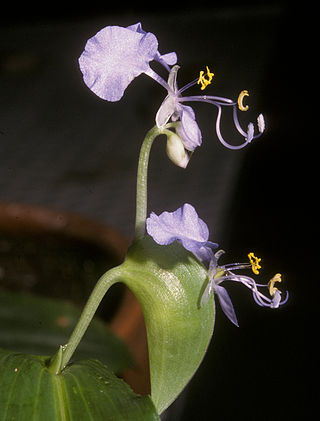
In botany, a bract is a modified or specialized leaf, especially one associated with a reproductive structure such as a flower, inflorescence axis or cone scale. Bracts are usually different from foliage leaves. They may be smaller, larger, or of a different color, shape, or texture. Typically, they also look different from the parts of the flower, such as the petals or sepals. A plant having bracts is referred to as bracteate or bracteolate, while one that lacks them is referred to as ebracteate and ebracteolate, without bracts.

Commelina is a genus of approximately 170 species commonly called dayflowers due to the short lives of their flowers. They are less often known as widow's tears. It is by far the largest genus of its family, Commelinaceae. The Swedish taxonomist Carl Linnaeus of the 18th century named the genus after the two Dutch botanists Jan Commelijn and his nephew Caspar, each representing one of the showy petals of Commelina communis.

Commelinaceae is a family of flowering plants. In less formal contexts, the group is referred to as the dayflower family or spiderwort family. It is one of five families in the order Commelinales and by far the largest of these with about 731 known species in 41 genera. Well known genera include Commelina (dayflowers) and Tradescantia (spiderworts). The family is diverse in both the Old World tropics and the New World tropics, with some genera present in both. The variation in morphology, especially that of the flower and inflorescence, is considered to be exceptionally high amongst the angiosperms.

Commelina tuberosa is an herbaceous perennial plant in the dayflower family which is native to Mexico but grown worldwide as an ornamental plant. It is characterized by its purple-splotched spathes with free margins, its bright blue petals of equal size, its tuberous roots, and its four to ten flowered lower cymes. In the wild, it is encountered in moist fields, open forests, or pine-oak forests. The species is sometimes considered to include the species Commelina coelestis, Commelina dianthifolia, and Commelina elliptica, such as in the Flora Mesoamericana. When these are treated as separate, they are often referred to as the "Commelina tuberosa complex". Horticulturally, the species are often treated as separate entities because of their differing habits and leaf shapes. In this sense, Commelina tuberosa is a low-growing plant with long narrow leaves.

Commelina communis, commonly known as the Asiatic dayflower, is an herbaceous annual plant in the dayflower family. It gets its name because the blooms last for only one day. It is native throughout much of East Asia and northern parts of Southeast Asia. In China, the plant is known as yazhicao, roughly translating to "duckfoot herb", while in Japan it is known as tsuyukusa, meaning "dew herb". It has also been introduced to parts of central and southeastern Europe and much of eastern North America, where it has spread to become a noxious weed. It is common in disturbed sites and in moist soil. The flowers emerge from summer through fall and are distinctive with two relatively large blue petals and one very small white petal.

Eurybia divaricata, the white wood aster, is an herbaceous plant native to eastern North America. It occurs in the eastern United States, primarily in the Appalachian Mountains, though it is also present in southeastern Canada, but only in about 25 populations in the provinces of Ontario and Quebec. In the U.S. it is abundant and common, but in Canada it is considered threatened due to its restricted distribution. It has been introduced to a number of countries in Europe. It can be found in dry open woods as well as along wood-edges and clearings. The species is distinguished by its flower heads that have yellow centers and white rays that are arranged in flat-topped corymbiform arrays, emerging in the late summer through fall. Other distinguishing characteristics include its serpentine stems and sharply serrated narrow heart-shaped leaves. The white wood aster is sometimes used in cultivation in both North America and Europe due to it being quite tough and for its showy flowers.

Commelina caroliniana, sometimes known as the Carolina dayflower, is an herbaceous plant in the dayflower family native to India and Bangladesh. Both the scientific name and the common name are misleading as the plant was described based on specimens found in the southeastern United States before it was known that the plant had in fact been introduced from India. It was most likely introduced to South Carolina in the late 17th century along with rice seed from India. The plant has also been recently reported from South Korea. Its flowers emerge from summer to fall and rarely into the winter.

Commelina benghalensis, commonly known as the Benghal dayflower, tropical spiderwort, or wandering Jew, kanshira in Bengali, is a perennial herb native to tropical Asia and Africa. It has been widely introduced to areas outside its native range, including to the neotropics, Hawaii, the West Indies and to both coasts of North America. It has a long flowering period, from spring to fall in subtropical areas, and throughout the year closer to the equator. It is often associated with disturbed soils.

Dudleya multicaulis is a succulent plant known by the common name manystem liveforever or many-stemmed dudleya. This Dudleya is endemic to southern California, where it is rare and seriously threatened as its habitat is altered by humans. Many occurrences of this species have been extirpated. This species is characterized by a few short, fingerlike cylindrical leaves with pointed tips, and its erect peduncle, which is topped with a branching inflorescence bearing up to 15 flowers on each long, thin branch. The flowers, which appear in late spring, have pointed yellow petals and long stamens. It is usually found on heavy clay or rocky soils and outcrops.

Dudleya pulverulenta is a species of perennial succulent plant known by the common names chalk lettuce, chalk dudleya, and chalk liveforever. It is one of the largest Dudleya, with a silvery, waxy rosette that may greatly contrast with its habitat. It is also regarded as one of the most distinctive members of the Dudleya, with the most advanced inflorescence in the genus, consisting of pendant, hummingbird pollinated flowers, the longest corolla, and the highest nectar output, along with the largest range of all the Dudleya, over 1,000 kilometres (620 mi), being found from southern Monterey County in California to the Sierra de San Borja in southern Baja California.

Bromus madritensis is a species of brome grass known by the common name compact brome. The specific epithet madritensis refers to Madrid, Spain. It has a diploid number of 28.

Commelina cyanea, commonly known as scurvy weed, is a perennial prostrate herb of the family Commelinaceae native to moist forests and woodlands of eastern Australia, Lord Howe Island and Norfolk Island. The blue flowers appear over the warmer months and are pollinated by bees and flies.

Commelina lukei is a monocotyledonous, herbaceous plant in the dayflower family from East Africa. This blue-flowered herb has been recorded in lowland areas of Kenya, Tanzania, and Madagascar, where it is found in a variety of habitats ranging from forests to grasslands to roadsides. Described in 2008, the species was previously confused with Commelina mascarenica and Commelina imberbis. Despite this misinterpretation, a third similar species, Commelina kotschyi, is actually most closely related to C. lukei. The plant's distinctive features include a scrambling habit, capsules with a rounded extension at the apex, appendaged seeds, clasping leaf bases throughout, and solely needle-like hairs along the upper side of the leaf's midrib. The species was named in honour of the botanist W. Q. R. Luke, whose collection of the plant served as the type specimen and allowed for a complete illustration and description.

Bromus erectus, commonly known as erect brome, upright brome or meadow brome, is a dense, course, tufted perennial grass. It can grow to 120 centimetres (47 in). Like many brome grasses the plant is hairy. The specific epithet erectus is Latin, meaning "erect". The diploid number of the grass is 56.
Commelina acutispatha is an herbaceous plant in the dayflower family found primarily in East and Central Africa, including limited distribution in the African Great Lakes country of Uganda. In addition to that country, it is known from Sierra Leone, Liberia, Ghana, Togo, Nigeria, Cameroon, Gabon, and the Democratic Republic of the Congo. It is a common species in regions of West Africa with significant forest cover, where it is often weedy. It is most common in disturbed, moist soils, in which it scrambles over other plants. The name Commelina thomasii was often used for West African plants until it was realized that Commelina acutispatha, an older name originally applied to plants from the Democratic Republic of the Congo, was the same species. The petals range in color from white to pale lilac to violet; the lower petal is about half as large as the upper paired petals. The central anther is reported to have a blue patch on the connective. It has solitary spathes borne on a peduncle covered in hook-hairs.

Commelina maculata is an herbaceous plant in the dayflower family found in India, Burma, Bhutan, and southern China. It is most often encountered along forest margins, in grasslands, along roadsides, or in moist ditches. The species is characterized by its short-stalked spathes with fused margins that usually occur in clusters of two or three, bearing flowers that barely stick out from the mouth of the spathe. The species is very similar to Commelina paludosa, and further study is needed to recognize the boundary between the two. The two are typically differentiated on the basis of C. paludosa having larger and more numerous spathes that occur in clusters of four to ten, forming a sort of head. C. paludosa is also reported to have larger leaves, a more erect habit, less branching, and thicker stems. On the other hand, C. maculata is supposed to have heads of only two to three spathes, low-growing stems, numerous branches, slender stems that root at the nodes, and leaves less than ten cm long by two and a half cm wide.
Commelina hockii is an herbaceous plant in the dayflower family found primarily in Central Africa, from southwestern Tanzania in the east, west through the Democratic Republic of the Congo and Zambia, and possibly extending further west to Angola. The species' distinctive features include its long, tapering spathes with unfused margins, its white flowers, and its many-flowered lower cymes. It can be found in grasslands and Brachystegia-dominated woodland. It is fairly unusual among Commelina species in having variation in the color of the antherodes, with some individuals having entirely yellow antherodes, while others contain a dark spot in the center. Also, it is one of the only Commelina species known to leave a papery residue of dried fluid inside its spathes; normally only fused-spathe species are known to produce this substance. Only one specimen from Angola resembles this species, but it has blue flowers, suggesting it may be a poorly understood and as-yet undescribed separate species. Commelina hockii is probably closely related to Commelina kituloensis, which shares a similar fruit type, the same tufted perennial habit, similar large spathes with dried fluid substance, and equally numerously flowered inflorescences. That species differs in having purplish flowers, hairy leaves, shorter spathes, and a preference for high altitude grassland.
Commelina polhillii is a plant species native to Tanzania, known only from the Iriniga and Mpanda Districts. It occurs in open woodlands and in disturbed sites.

Calectasia hispida, commonly known as blue tinsel lily or hispid tinsel lily, is a plant in the family Dasypogonaceae growing as a rhizomatous, erect, clumping perennial herb. It is endemic to the south-west of Western Australia and is common in most of its range. It is similar to the other species of Calectasia and is distinguished from them mainly by the hairiness of its leaves and the glabrousness of the throat of the flowers.
Hypericum cuisinii is a perennial herb in the genus Hypericum, in the section Adenosepalum. The herb has pale yellow flowers and occurs in Greece and Turkey.


















